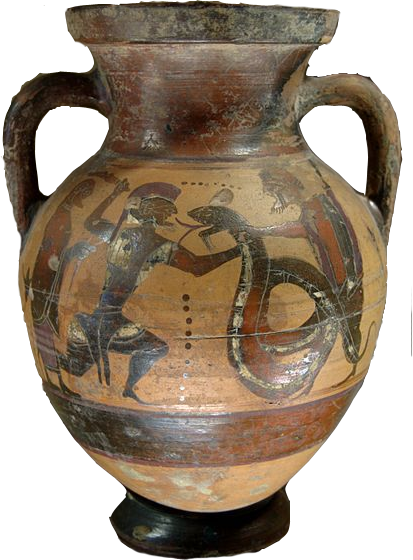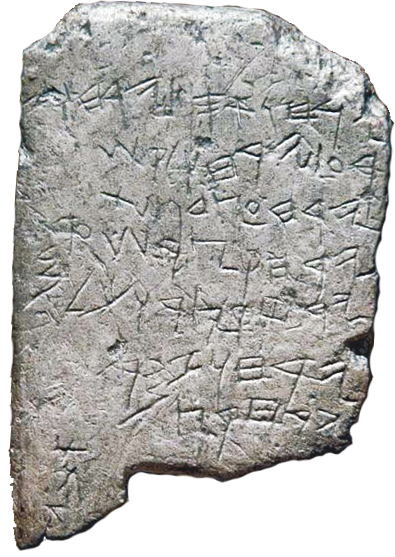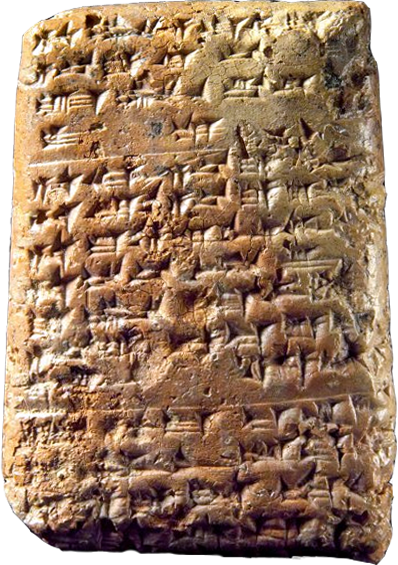Alphabet


The legend of princess Europa of Tyre evokes the journey of Cadmus in Greece and his cultural offering to people in exchange for information about his sister's abduction. This legend joins the historical reality with story of Herodotus, who noted: "The Phoenicians arrived [in Greece] with Cadmus [...] introduced the alphabet that the Greeks, which I believe, didn't have it before". A few centuries after Herodotus, it was the turn of the Roman author Pliny the Elder to write: "The Phoenician people have the honor of inventing the alphabetical letters".

However, all the ancients were not of the same opinion. Diodorus of Sicily, a Greek historian in the first century BC, relates the Cretans point of view on the question: "Against those who say that the Syrians invented the alphabetical letters and that the Phoenicians, after having learned them, transmitted the Alphabet to the Greeks, they [... Cretans] say that the Phoenicians, at origin, didn't invent the letters, but they only changed the form of the signs"(1).
According to these witnesses and other documents, it seems clear that the importance of Phoenicians in the history of alphabet was recognized by all. But there were different opinions on their actual role. For some people, The Phoenicians were the inventors and propagators of the alphabet, and for others the Phoenicians have been considered as mere intermediaries who have delivered the invention of another people to the Greeks, which helped to give the alphabet its final form.
Facing the Phoenicians mission, somewhat controversial, it remains to consider the issue in light of archaeological discoveries which, as they evolve, allow to provide more rational responses on these interrogations.
Each one of the great civilizations that flourished around the Mediterranean had its own script system. Although the styles were different, all these scriptures were based on transcripts of ideas through pictographic forms. Three of these script systems were the most representative:
This general evocation does not include the Syrian-Palestinian region, which included Phoenicia. Geographically placed between Mesopotamia and Egypt, this area has always been exposed to political and cultural influences of its two powerful neighbors. Several Egyptian and Babylonian documents were discovered, some of which date back to the third millennium (in cuneiform and hieroglyphic). In the first centuries of the second millennium, view that the political situation in the region has improved, some autonomy propagated, and cities sought to have its own graphics system. Although Babylonian scripting (using cuneiform) remained the language of international relations and culture, some degree of independence was sensed in terms of writing, and the population sought to replace Egyptian and Babylonian systems, the rather complex and difficult to learn. There was therefore, in various times and places, several attempts in order to invent an autonomous and simple writing.
Before discussing the origin of the classical Phoenician alphabet, the ancestor of almost all alphabetic systems of the world, we will take a look of the first writing methods of alphabetic characters that have appeared in the area and that influenced the evolution of the Phoenician alphabet.
The Proto-Canaanite inscriptions: also called Pseudo-hieroglyphic, were discovered in the regions of Levant (Lebanon, Palestine and Syria). They are very similar to the Egyptian hieroglyphics, representing animals, plants, instruments, geometric patterns, etc. This script, essentially syllabic, including not more than 120 Symbols, remained indecipherable despite the efforts of leading experts.
The Proto-Sinaitic script: composed of a set of graffiti (there are 25 symbols) in large part un-deciphered, found on Serabit el-Khadim site into Sinai near the turquoise mines operated by the pharaohs around year 1600 BC. These inscriptions have allowed to distinguish an alphabetical writing system with 23 different signs mono-consonants but, once combined, constituted a complete alphabet. Some forms look like simplified Egyptian hieroglyphics and others more like the Phoenician letters.


Cuneiform tablets of Ugarit: were discovered in the late 1920s on the archeological site of Ras Shamra (on Syrian coast), the northern part of Phoenicia. They dated from the thirteenth century BC and are closer, by their style, to the Mesopotamian writing system. The scribes of Ugarit wrote on clay tablets using a cuneiform alphabet of 30 symbols(2). The richness of the founded texts lies in their diversity (diplomatic texts, commercial treaties, legal documents, etc.). Some researchers defend the idea that the city of Ugarit might have been influenced by two previous scriptures because of its geographical location at the crossroads of diplomatic and trade relations between dominating powers of that time.
But can we confirm that one of these systems is the direct ancestor of the Phoenician alphabet?
The first two systems are so far only partially decrypted, while the third uses cuneiform signs. It is undeniable that the Phoenician alphabet was inspired profoundly by the evolution brought by these three systems (more phonetic than pictographic), and their performance vis-à-vis old writing systems (limited number of characters). But could we indicate more direct link? A more complete deciphering of these systems might have shed us some light to confirm or not this "ancestral" link.
R. Weill(3) noted: "The Phoenician [Alphabet] alone among its competitors, must live and ensure its makeshift in the world and in the course of centuries, but what should we conclude from this multiplicity, as to the means of the general invention? We may simply conclude that the invention was ready in which are very civilized Semitic Mediterranean countries, that the principle came to appear from one end to the other all over the Syro-Palestinian area, and that the systems arrived at hatching without prior waiting; every system on its way, at various points, and entirely under different forms following circumstances and local influences and according to the ingenuity and imagination of the original inventors."
The Phoenician alphabet contains 22 letters (consonants). It is written like Arabic and Hebrew, from right to left. Its mystery was discovered in 1758 by the Abbe Bartholomew, a literate of the Enlightenment. To decrypt this alphabet, he based his studies on bilingual texts (Greco-Phoenician, inscriptions founded in Malta) and on Tyrian's engravings currencies. He recognized the first characters by identifying a few names and especially some proper nouns like Tyr, Melqart. Supposing that the Phoenician language like Hebrew, and assuming that it includes 22 letters, he noted the consonants, and after, he interpreted a few simple words and made a comparison with the Greek version which finally enabled him to read an entire text and distinguish all the Phoenician letters(4).
The hardest part of the decryption of the Phoenician alphabet was due to the deficiency of references and engravings. Phoenicians have not left a lot of written documents, archaeological excavations have revealed a few royal inscriptions, dedications to the gods or funerary texts found on monuments, inscribed on the stone with the Phoenician alphabet for eternity.
Other inscriptions were spotted here and there on the expedition's road in the various colonies founded by the Phoenicians. The most interesting could have been the discovery of correspondences, contracts or commercial acts (the use of perishable supplies, especially the papyrus, did not allow the safeguarding of such documents), which were the main reason for the development of the alphabet and its expansion engine through the ancient world. Some even said that the motivation which inspired the Phoenicians was the convenience and utility offered by the alphabet and the services it could offer to the industrialists and traders in their accounts and contacts.
Among the most famous texts: the inscription in memory of Ahiram King of Goubal (Byblos), engraved in 1000 BC by his son on a reused sarcophagus, is considered the first truly Phoenician inscription. It uses 19 of the 22 letters of the alphabet and contains separation traits between words.
Some other inscriptions, also in royal character, date back to the Persian period when Sidon became the dominant city of the Phoenician coast. Its kings engraved large dedications to the city gods and inscribed cautions on their tombs against thieves. The funerary inscription on the sarcophagus of King Echmounazor remains one of the most evocative. However, the alphabet used in Sidon had more advanced forms than those on the sarcophagus of Ahiram Byblos few centuries earlier. The use of minting coins, which also appeared at the time, gave the opportunity to decorate the coins with the monogram of King or the name of the city using Phoenician's alphabetical characters.
The Phoenician alphabet, with the arrival of Alexander the Great, was replaced by Greek as written language. However, rare inscriptions attest to the persistence of the use of Phoenician until the end of the first millennium. The Phoenicians continued until II°-III° centuries, for sake of identity, to burn the Phoenician name of their cities on their currencies(5).

From the tenth century BC, the Phoenician alphabet was adopted by neighboring peoples to record their own inscriptions. Aramean, Hebrew, people of Transjordan were gradually evolving this alphabet in such a way to have distinct local forms. Aramaic writing, used by the Assyrian Chancery together with Akkadian, was later disseminated by the Persians in the entire west of their empire, from Egypt and the Anatolian coast to Babylon. It formed for several centuries, the lingua franca of the Middle East, before being supplanted by Arabic with the Islamic conquest.
The development and the propagation of Phoenician script in the Middle East and the Mediterranean was particularly favored by the mercantile activity of Phoenician merchants who traveled all over the seas and straits, searching for new markets to their products. There were inscriptions in Phoenician in almost all countries around the Mediterranean, from ninth century BC on some monuments in Cyprus and Aleppo, and from the eighth century in Anatolia and Sardinia, without forgetting the scriptures found in Mesopotamia, Greece, Italy, Spain, Egypt ...
The greatest transfer was accomplished with the introduction of the Phoenician alphabet to Greece, with the arrival of Cadmus in search of his sister, the princess Europe. The Greeks, who lost the use of writing with the disappearance of the Mycenaean world in the early twelfth century BC, adopted immediately the Phoenician alphabet. But that alphabet has had to adapt requirements of the New Greek language by introduction vowels. Therefore we can say that the Greek alphabet is considered the first complete alphabet (consonants and vowels). Later, the Etruscans transmit that alphabet to the Romans who realized some adjustments for a better adaptation, which initiate a new language: the current Latin alphabet which was spread by the Europeans, all around the world.
| (1) | G. Garbini, "la question de l'alphabet", in Les Phéniciens, Direction scientifique de Sabatino Moscati, Stock, Paris, 1997. | Retour texte |
| (2) | F. Briquel-Chatonnet & E. Gubel, Les Phéniciens. Aux origines du Liban, Découvertes Gallimard, Paris,1998. | Retour texte |
| (3) | R.Weill, La Phénicie et l'Asie occidentale (des origines à la conquête macédonienne), A. Colin, Paris, 1939. | Retour texte |
| (4) | F. B.-C. & E. G., Idem. | Retour texte |
| (5) | F.B.C. & P.B., "l'alphabet phénicien", Liban, l'autre rive, Flammarion, IMA, 1998. | Retour texte |